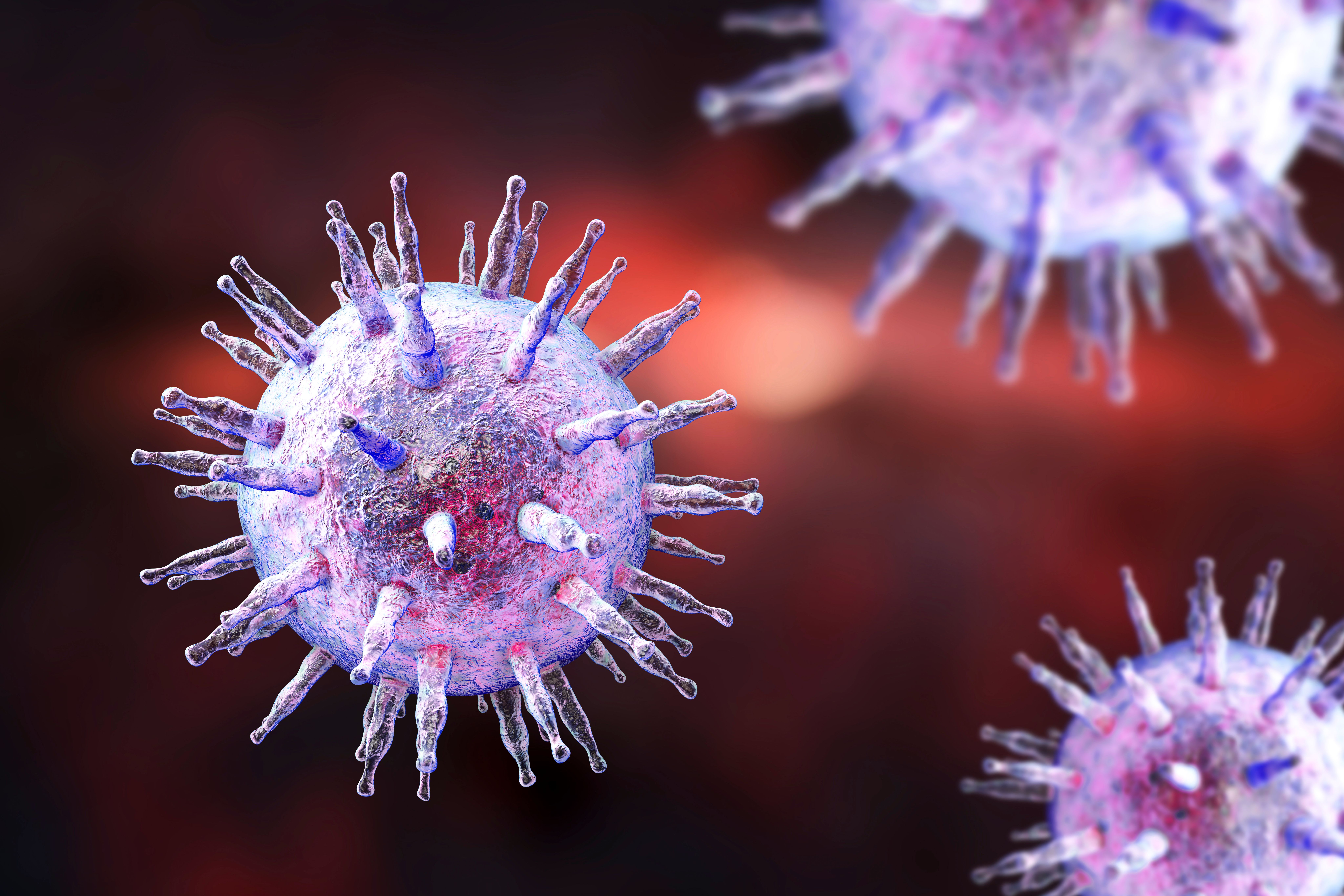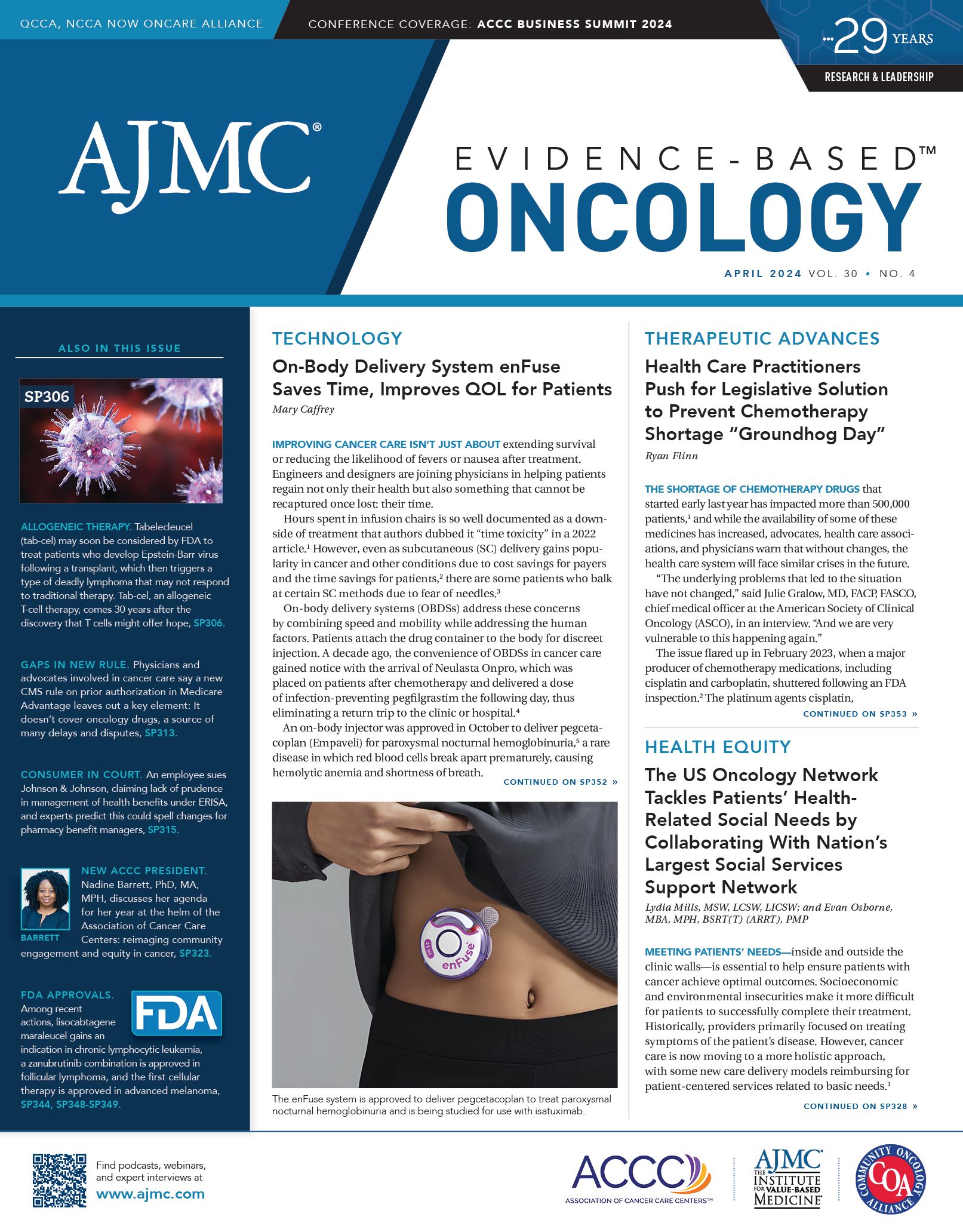- Center on Health Equity & Access
- Clinical
- Health Care Cost
- Health Care Delivery
- Insurance
- Policy
- Technology
- Value-Based Care
As FDA Filing Approaches for Tab-Cel in EBV+ PTLD, Decades of Science Bear Fruit
Approved in Europe, tabelecleucel may soon be considered by FDA to treat patients who develop Epstein-Barr virus following a transplant, which then triggers a type of deadly lymphoma that may not respond to traditional therapy. Tab-cel, an allogeneic T-cell therapy, comes 30 years after the discovery that T cells might offer hope, followed by decades of research on how to harness them without the side effects.
Cancer can emerge from many corners. For some patients, it can start with a cure.
Patients may seek an allogeneic hematopoietic stem cell transplant (HSCT) to treat a blood cancer or an immune disorder. They may undergo a solid organ transplant (SOT), such as a new kidney to resolve renal failure. For many patients, these are lifesaving treatments. But for a small number, a transplant sets off Epstein-Barr virus (EBV), which affects up to 90% of the population at some point, many of whom may not show symptoms.1
For those taking immunosuppressive drugs after a transplant, however, it’s another story.
EBV lingers in B cells. With immunosuppression dampening a patient’s normal T-cell response, the virus can multiply, triggering a potentially fatal complication called EBV-positive (EBV+) posttransplant lymphoproliferative disease (PTLD),2 in which the virus kicks off a type of lymphoma.
The standard treatment is rituximab. Although relatively uncommon, especially following HSCT, when patients fail to achieve remission, overall survival following HSCT remains grim.3 And if patients who develop EBV+ PTLD following SOT fail to respond to the usual treatment of rituximab or rituximab with chemotherapy, 2-year survival rates are around 10%.4
Epstein-Barr virus | Image: Dr Microbe

A New Treatment Option
The makers of a novel T-cell therapy to treat EBV+ PTLD are expected to file a biologics license application (BLA) with the FDA before this summer. Tabelecleucel, or tab-cel, is an allogeneic therapy—meaning it is manufactured for use by an unspecified patient. This offers several advantages over treatments such as chimeric antigen receptor (CAR) T-cell therapies that are customized for an individual patient. The treatment, now sold as Ebvallo by Pierre Fabre in the European Union and being developed by Atara Biotherapeutics in the United States,5 is given intravenously in 35-day cycles; in each cycle, the therapy is administered once weekly for 3 weeks.6
Phase 3 findings from the ALLELE study (NCT03394365) were published recently in The Lancet Oncology, showing that 22 of 43 patients with refractory EBV+ PTLD treated with tab-cel achieved an objective response; those who responded had longer overall survival (OS) than nonresponders.6 The estimated 1-year OS for responders was 84.4% (95% CI, 58.9%-94.7%) compared with 34.8% for nonresponders (95% CI, 14.6%-56.1%). Interim results had been presented in December 2022 at the American Society of Hematology Annual Meeting and Exposition.6,7
Tab-cel comes after decades of research to understand how to harness T cells to fight EBV-associated lymphoma while sidelining harmful effects. It’s work that Susan Prockop, MD, has been doing for years, first at Memorial Sloan Kettering Cancer Center (MSK) before she became the program director for Clinical and Translational Research at Dana-Farber/Boston Children’s Cancer Institute.
Prockop is the senior author of the ALLELE study, which the authors said broke new ground as the first publication of phase 3 results for an allogeneic, EBV-specific T-cell therapy in a peer-reviewed journal.
“The use of viral-specific T cells started over 20 years ago, and it has been shown by a number of different studies in a number of different settings to be effective in patients who fail to respond to rituximab alone or rituximab and chemotherapy,” Prockop said in an interview. “This is a demonstration of the efficacy in a patient population that, overall, otherwise has a very poor prognosis.”
The success of tab-cel comes not just in the responses, but also in the relative lack of adverse events, which Prockop attributes both to features of the T-cell generation process and to patients’ status prior to treatment.
As the ALLELE authors wrote, “These data represent a potentially transformative and accessible treatment advance for patients with relapsed or refractory disease with few treatment options,” offering hope for patients “for whom there are no other approved therapies, without evidence of safety concerns seen with other adoptive T-cell therapies.”6
Susan Prockop, MD | Image: Dana-Farber Cancer Institute

ALLELE Phase 3 Results
In ALLELE, investigators enrolled 63 patients from June 27, 2018, to November 5, 2021; those eligible to continue included 43 patients, 24 male and 19 female patients (56% vs 44%). Additional results were as follows6:
- Among those treated, 14 had prior HSCT, and 29 had SOT.
- Seven of 14 in the HSCT group (50%; 95% CI, 23%-77%) and 15 of 29 in the SOT group (52%; 95% CI, 33%-71%) had an objective response, with a median (IQR) follow-up of 14.1 months (5.7-23.9) and 6.0 months (1.8-18.4), respectively.
- In the HSCT group, the best overall response was a complete response (CR) in 6 (43%), partial response (PR) in 1 (7%), stable disease (SD) in 3 (21%), progressive disease (PD) in 2 (14%), and not evaluable (NE) in 2 (14%) patients. Median time to response was 1.0 month. Clinical benefit was seen in 10 of 14 patients (71%).
- Among the HSCT group, estimated 1-year overall survival was 70.1% (95% CI, 38.5%-87.6%), and estimated median overall survival (OS) was not reached.
- In the SOT group, the best overall response was CR in 6 (21%) PR in 9 (31%), SD in 2 (7%), PD in 7 (24%), and NE in 5 (17%). Median time to response was 1.1 months. Clinical benefit was seen in 17 (59%) of 29 participants.
- Among the SOT group, estimated 1-year OS was 56.2% (95% CI, 34.6%-73.2%) and estimated median OS was 16.4 months (95% CI, 5.0-NE).
Adverse events. The most common adverse events were disease progression; this was seen in 4 of 14 (29%) among the HSCT group and 8 of 29 (28%) in the SOT group. Investigators reported decreased neutrophil count in 4 of 14 (29%) in the HSCT group and 4 of 29 (14%) in the SOT group. Other findings included the following:
- Treatment-emergent serious adverse events were reported in 23 of 43 patients (53%). Fatal treatment-emergent adverse events occurred in 5 patients (12%). No treatment-emergent death was treatment related.
- Of significance, there were no reports of graft-vs-host disease, marrow rejection, cytokine release syndrome (CRS), immune effector cell-associated neurotoxicity syndrome, or rejection of a SOT related to tab-cel.6
A Long Road to Success
The full story of tab-cel goes back to 1994, when an MSK research group showed how T-cell infusions generated from stem cell transplant donors eliminated EBV+PTLD in 5 recipients, but with serious adverse effects.8 Prockop described these findings, in which patients were given T-cells from transplant donors.
“It was demonstrated…that T cells from the original stem cell transplant donor could eradicate EBV+PTLD, even in the [central nervous system]. However, giving bulk T cells resulted in at least 20% of patients developing significant graft vs host disease, meaning those T cells could eradicate EBV, but could also recognize other aspects of non-self and cause GVHD.
“And so, the idea was, could you isolate the EBV-specific T cells from those bulk T cells and eradicate PTLD using that approach?”
At MSK, the team pursued a strategy, initially pioneered at Baylor, to generate EBV+ specific T cells lines in advance. This was necessary, Prockop explained, because while EBV+ PTLD is rare, it progress rapidly, and generating T-cells using this process is time-consuming. Although the number of EBV+ PTLD cases is small, she said, it is well-known which transplant patients are at risk.
.Key milestones came when it was demonstrated these pregenerated T cell lines could eliminate EBV+ PTLD, and when it was shown that T cells could be in a human leukocyte antigen (HLA) mismatched setting for either stem cell or solid organ transplant recipients. This second step would prove key in the development of tab-cel.
Building a Bank of T-Cell Lines
Creating a bank of T-cell lines to treat patients with EBV+ PTLD required studies to determine how best to match donor lines with patients. Investigators had to understand what the T-cell receptors in each line would recognize, and Prockop explained that they were “not in the practice of categorizing what EBV antigen the T cell recognized.”
But they were able to categorize the HLA allele that each T cell recognized. “And so, the idea was, you could use a T-cell line in somebody who was very mismatched to the T-cell line as long as you shared the HLA allele through which the T-cell line recognized EBV,” she said. In the trials at MSK, donors to the T-cell bank and recipients shared 2 HLA alleles, she said.
Prockop was the lead author of a 2020 paper in the Journal of Clinical Investigation9 that outlined this approach, along with a dose escalation strategy that led to the current 3-dose cycle. In the paper, investigators explain at length their hypotheses and steps that led to the current strategy, which calls for shifting to a different HLA restriction in the subsequent 35-day cycle if patients do not respond to the first one.
The lack of adverse effects. In addition, these experiments also showed how the in vivo expansion approach of the EBV T cells would allow repeat infusions without CRS or other effects seen in CAR T-cell therapy.
Features in the product development contribute to the lack of adverse events, Prockop explained. The process develops an “antigen-presenting cell—essentially a transformed B-cell—that expresses antigens of EBV. And those cells are co-cultured with T cells from the same donor. So, the expansion is happening in an autologous setting,” she said. Expansion typically takes up to 4 weeks—much longer than the CAR T-cell process—and there is no artificial activation.
Because the therapy is “off the shelf,” patients are treated within 1 to 2 days of the decision; Prockop explained there is no lymphodepleting chemotherapy before infusion. “While patients are immune-incompetent, and they have defects in their EBV-specific immunity, there isn’t an acute application of lymphopenia just prior to the infusion of the T cells,” she said.
The combination gives patients the best of all worlds in treatment: sustained exposure to T cells without the CRS and other events that have caused clinicians to limit doses with other therapies. Prockop said, “The safety, combined with the efficacy, is what allows these repeat infusions.”
Approved in Europe, FDA Filing Next
In December 2022, the European Commission granted tab-cel marketing authorization under orphan drug designation for patients who have received at least 1 prior therapy.5 And at the European Society for Medical Oncology Immuno-oncology Congress in December 2023, Atara Biotherapeutics announced phase 2 results for tab-cel’s use in in EBV+ PTLD involving CNS.10
In June 2023, during the American Society of Clinical Oncology (ASCO) annual meeting in Chicago, data were presented for 27 European patients treated with tab-cel through an expanded access program. Of the group, 24 patients with relapsed/refractory EBV+ PTLD received at least 1 dose of tab-cel; this included 16 post-SOT and 8 post-HSCT patients; 4 had primary CNS PTLD. An objective response rate of 66.7% was observed for both the SOT and HSCT groups (95% CI, 44.7%-84.4%); rates were 56.3% (9/16) for the SOT patients and 87.5% (7/8) for the HSCT patients. The best overall response was CR (33.3%; 4 SOT and 4 HSCT) or PR (33.3%; 5 SOT and 3 HSCT). Survival rates at 1 year were 73.7% for both groups.11
“These real-world results affirm the favorable risk-benefit profile seen in the pivotal phase 3 ALLELE study which supported tab-cel as the first-ever allogeneic T-cell immunotherapy approved,” AJ Joshi, MD, then-chief medical officer, Atara, said in a statement released during the ASCO 2023 meeting. “Tab-cel was well tolerated and delivered a 1-year survival rate of nearly 91% in responders, reinforcing its potential to address an urgent unmet medical need for EBV+ PTLD patients.”12
“We are preparing for our tab-cel BLA submission in the second quarter of 2024. We look forward to interacting with the FDA to progress towards approval based on our robust clinical data,” Rajani Dinavahi, MD, senior vice president and chief medical officer for Atara Biotherapeutics, Inc., said in an email.
References
- Epstein-Barr virus and infectious mononucleosis. CDC. Updated September 28, 2020. Accessed February 20, 2024. https://bit.ly/3I2LdjE
- Martinez OM, Krams SM. The immune response to Epstein-Barr virus and implications for posttransplant lymphoproliferative disorder. Transplantation. 2017;101(9):2009-2016. doi:10.1097/TP.0000000000001767
- Socié G, Barba P, Barlev A, et al. Outcomes for patients with EBV-positive PTLD post-allogeneic HCT after failure of rituximab-containing therapy. Bone Marrow Transplant. 2024;59(1):52-58. doi:10.1038/s41409-023-02127-9
- Shahid S, Prockop SE, Epstein-Barr virus-associated post-transplant lymphoproliferative disorders: beyond chemotherapy treatment. Chancer Drug Resist. 2021;4(3):646-664. doi:10.20517/cdr.2021.34
- Atara Biotherapeutics’ Ebvallo (Tabelecleucel) receives European Commission approval as first-ever therapy for adults and children with EBV+ PTLD. News release. Atara Biotherapeutics. December 19, 2022. Accessed February 20, 2024. https://bit.ly/3I7bwVK
- Mahadeo KM, Baiocchi R, Beitinjaneh A, et al. Tabelecleucel for allogeneic haematopoietic stem-cell or solid organ transplant recipients with Epstein–Barr virus-positive post-transplant lymphoproliferative disease after failure of rituximab or rituximab and chemotherapy (ALLELE): a phase 3, multicentre, open-label trial. Lancet Oncol. Published online January 31, 2024. doi:10.1016/S1470-2045(23)00649-6
- Atara Biotherapeutics and Pierre Fabre Laboratories announce publication of phase 3 ALLELE Tab-cel data in The Lancet Oncology. News release. Atara Therapeutics. January 31, 2024. Accessed February 20, 2024. https://bit.ly/3UNAjFR
- Papadopoulos EB, Ladanyi M, Emanuel D, et al. Infusions of donor leukocytes to treat Epstein-Barr virus-associated lymphoproliferative disorders after allogeneic bone marrow transplantation. N Engl J Med. 1994;330(17):1185-1191. doi:10.1056/NEJM199404283301703
- Prockop S, Doubrovina E, Suser S, et al. Off-the-shelf EBV-specific T cell immunotherapy for rituximab-refractory EBV-associated lymphoma following transplantation. J Clin Invest. 2020;130(2):733-747. doi:10.1172/JCI121127
- Atara Biotherapeutics to present positive new tab-cel data during oral session at ESMO Immuno-oncology Congress 2023. News release. November 29, 2023. Accessed February 20, 2024. https://bit.ly/3T4yvaa
- Choquet S, Clark A, Renard C, et al. Effectiveness and safety outcomes in patients with EBV+ PTLD treated with allogeneic EBV-specific T-cell immunotherapy (tabelecleucel) under an expanded access program (EAP) in Europe. J Clin Oncol. 2023;41(16):Abstr 7521. doi:10.1200/JCO.2023.41.16_suppl.7521
- Atara Biotherapeutics presents updated tab-cel clinical effectiveness data at ASCO 2023. News release. Atara Biotherapeutics. June 5, 2023. Accessed February 22, 2024. https://bit.ly/3IcxTsQ

